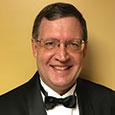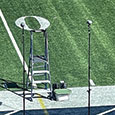To some directors, it may seem that the Midwest Clinic has been around almost forever, perhaps since John Philip Sousa was a boy. However, like the towering oak tree, this institution began as a simple acorn in 1946, the year after World War II ended. The second issue of this magazine included a small announcement about a “reading session at VanderCook College” and listed Howard Bachman and Irving Tallmadge as directors to read through some new literature.
A year later we published a short news item announcing the “Midwest Clinic” to be held at Chicago’s Hotel Sherman on December 12-13. The next year the news announcement proclaimed the “Second Annual Midwest Band Clinic.” Note the additional of the word band. Two years later there was a major increase in ambitions, and the event became the “Mid-West National Band Clinic” with the then fashionable hyphen, which hung stubbornly on for 46 years.
The word national endured from 1950 to 1986, when it was replaced by the more grandiose International. Many of us have observed with amusement how many tiny, podunk airports proudly proclaim themselves to be international airports. However, sense eventually prevailed when the Midwest came full circle in December 1996, when an event announcement proclaimed that the 51st Midwest Clinic would be held at the Chicago Hilton and Towers. This is the title used 49 years before in 1947.
During the 1950s and 1960s, the founding publisher of The Instrumen-talist repeatedly implored the Midwest to add an orchestra day. Not until the August 1968 issue was it was announced that the “22nd Annual Mid-West National Band Clinic and Orchestra Day” would be held in December. Some rational-thinking member on the Midwest Board must have decided that this name was too unwieldly for any event, and the next issue of the magazine cited the “22nd Annual Midwest National Band-Orchestra Clinic.
By any name, the Midwest has evolved from a small gathering of colleagues into a mecca for directors to meet, to learn, and to admire the success of old friends and those soon to be. Many directors performed here when they were students and now stand on the podium themselves. One person who deserves considerable credit for this growth and prestige is John Paynter, who raised the level of the Midwest in every way and led the organization for many years.
Time brings change, some good, some bad. In the past it was obligatory to reserve a hotel room a year in advance and pay the exhibit fee immediately because space was limited. McCormick Place now offers ample exhibition space and meeting rooms, but many of us miss the bustle of the old Hilton basement into the main exhibit hall. If you didn’t see an old friend there, it was inevitable that you would in the large basement foyer. Some of the legends who were there every year included Alfred Reed, Kent Smith, Fred Fennell, Harvey Phillips, Betty Ludwig, Vito Pascucci, Bob Foster, and all the others.
I recall seeing Himie Voxman at about age 90, his five-foot frame moving slowly through the pinch of people near those double doors at the Hilton. I asked he needed help, and he replied that he was looking for a particular booth to examine a clarinet. I guided him down the long hallway to the instrument room, the last time I saw this giant. He was still curious about what was new after so many decades in the profession. Of course, he came to the Midwest to learn. Everybody does.
James T. Rohner
Publisher Emeritus




